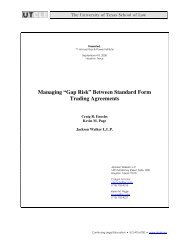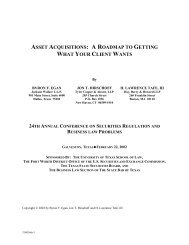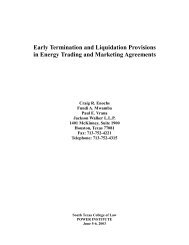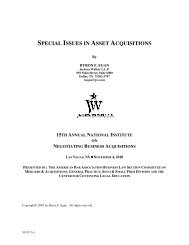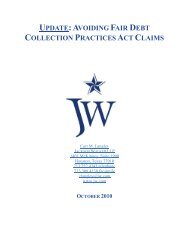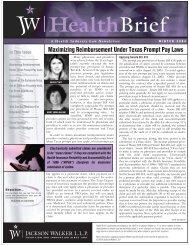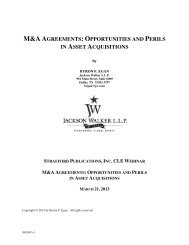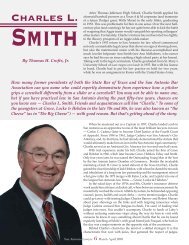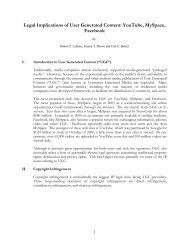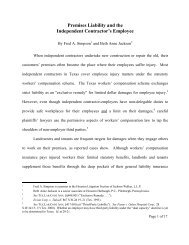busted m&a deals headed for litigation - Jackson Walker LLP
busted m&a deals headed for litigation - Jackson Walker LLP
busted m&a deals headed for litigation - Jackson Walker LLP
You also want an ePaper? Increase the reach of your titles
YUMPU automatically turns print PDFs into web optimized ePapers that Google loves.
may want the definition to encompass “com<strong>for</strong>t letters” confirming the Seller’s intention to<br />
provide financial support to a subsidiary or other related person and assurances to employees<br />
regarding compensation, benefits, and tenure, whether or not such letters or assurances are<br />
legally binding.<br />
“Damages” -- as defined in Section 11.2.<br />
“Disclosing Party” -- as defined in Section 12.1.<br />
“Disclosure Letter” -- the disclosure letter delivered by Seller and Shareholders to Buyer<br />
concurrently with the execution and delivery of this Agreement.<br />
COMMENT<br />
The <strong>for</strong>m and content of the Disclosure Letter (sometimes called a disclosure<br />
schedule) should be negotiated and drafted concurrently with the negotiation and drafting of<br />
the acquisition agreement. The Disclosure Letter is an integral component of the acquisition<br />
documentation and should be prepared and reviewed as carefully as the acquisition<br />
agreement itself. The Buyer may prefer to attach multiple schedules or exhibits to the<br />
acquisition agreement instead of using a disclosure letter.<br />
“Effective Time” -- [The time at which the Closing is consummated.] [__________ on the<br />
Closing Date.]<br />
COMMENT<br />
Under the Model Agreement, if the Closing occurs, the Effective Time fixes the time<br />
at which the transfer to the Buyer of the assets and the risks of the business and the<br />
assumption by the Buyer of liabilities are deemed to have taken place, regardless of the<br />
actual time of consummation of the transaction.<br />
Normally the Effective Time will be the time when payment <strong>for</strong> the assets is made,<br />
at the consummation of the Closing. Sometimes acquisition agreements specify an effective<br />
time at the opening or closing of business on the closing date, or even (in the case of a<br />
business, such as a hospital, that operates and bills on a twenty-four hour basis) 12:01 a.m.<br />
on the Closing Date. This must be done with care, however, to avoid unintended<br />
consequences, such as the buyer having responsibility <strong>for</strong> an event that occurs after the<br />
Effective Time but be<strong>for</strong>e the Closing or the seller having responsibility <strong>for</strong> an event that<br />
occurs after the Closing but be<strong>for</strong>e the Effective Time.<br />
Many drafters do not use a general definition of effective time and simply treat the<br />
closing as if it occurred at a point in time on the closing date. If the parties agree on an<br />
effective time <strong>for</strong> financial and accounting purposes that is different from the time of the<br />
closing, this can be accomplished by a sentence such as the following: “For financial and<br />
accounting purposes (including any adjustments pursuant to Section 2.8), the Closing shall<br />
be deemed to have occurred as of __________ on the Closing Date.”<br />
“Encumbrance” -- any charge, claim, community property interest, condition, equitable<br />
interest, lien, option, pledge, security interest, mortgage, right of way, easement, encroachment,<br />
servitude, right of first option, right of first refusal or similar restriction, including any restriction on<br />
4032470v.1<br />
- 29 -




